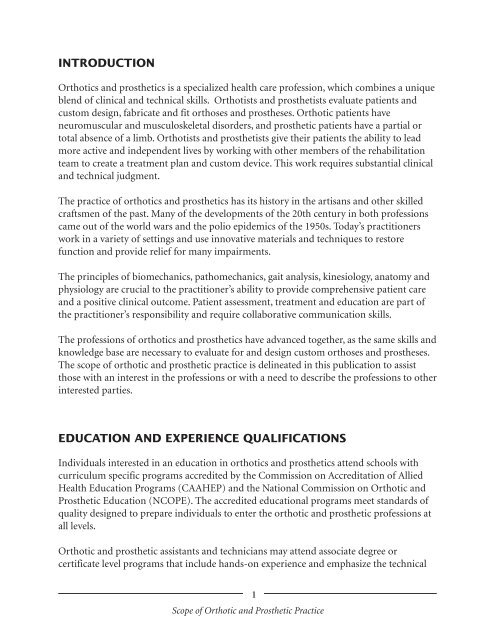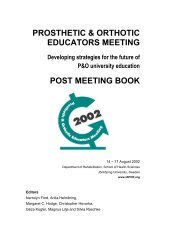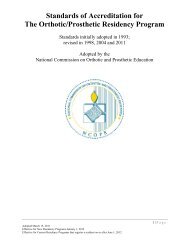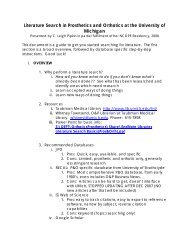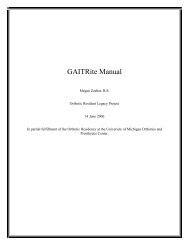Scope of Practice - NCOPE
Scope of Practice - NCOPE
Scope of Practice - NCOPE
Create successful ePaper yourself
Turn your PDF publications into a flip-book with our unique Google optimized e-Paper software.
INTRODUCTION<br />
Orthotics and prosthetics is a specialized health care pr<strong>of</strong>ession, which combines a unique<br />
blend <strong>of</strong> clinical and technical skills. Orthotists and prosthetists evaluate patients and<br />
custom design, fabricate and fit orthoses and prostheses. Orthotic patients have<br />
neuromuscular and musculoskeletal disorders, and prosthetic patients have a partial or<br />
total absence <strong>of</strong> a limb. Orthotists and prosthetists give their patients the ability to lead<br />
more active and independent lives by working with other members <strong>of</strong> the rehabilitation<br />
team to create a treatment plan and custom device. This work requires substantial clinical<br />
and technical judgment.<br />
The practice <strong>of</strong> orthotics and prosthetics has its history in the artisans and other skilled<br />
craftsmen <strong>of</strong> the past. Many <strong>of</strong> the developments <strong>of</strong> the 20th century in both pr<strong>of</strong>essions<br />
came out <strong>of</strong> the world wars and the polio epidemics <strong>of</strong> the 1950s. Today’s practitioners<br />
work in a variety <strong>of</strong> settings and use innovative materials and techniques to restore<br />
function and provide relief for many impairments.<br />
The principles <strong>of</strong> biomechanics, pathomechanics, gait analysis, kinesiology, anatomy and<br />
physiology are crucial to the practitioner’s ability to provide comprehensive patient care<br />
and a positive clinical outcome. Patient assessment, treatment and education are part <strong>of</strong><br />
the practitioner’s responsibility and require collaborative communication skills.<br />
The pr<strong>of</strong>essions <strong>of</strong> orthotics and prosthetics have advanced together, as the same skills and<br />
knowledge base are necessary to evaluate for and design custom orthoses and prostheses.<br />
The scope <strong>of</strong> orthotic and prosthetic practice is delineated in this publication to assist<br />
those with an interest in the pr<strong>of</strong>essions or with a need to describe the pr<strong>of</strong>essions to other<br />
interested parties.<br />
EDUCATION AND EXPERIENCE QUALIFICATIONS<br />
Individuals interested in an education in orthotics and prosthetics attend schools with<br />
curriculum specific programs accredited by the Commission on Accreditation <strong>of</strong> Allied<br />
Health Education Programs (CAAHEP) and the National Commission on Orthotic and<br />
Prosthetic Education (<strong>NCOPE</strong>). The accredited educational programs meet standards <strong>of</strong><br />
quality designed to prepare individuals to enter the orthotic and prosthetic pr<strong>of</strong>essions at<br />
all levels.<br />
Orthotic and prosthetic assistants and technicians may attend associate degree or<br />
certificate level programs that include hands-on experience and emphasize the technical<br />
1<br />
<strong>Scope</strong> <strong>of</strong> Orthotic and Prosthetic <strong>Practice</strong>


